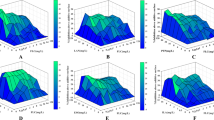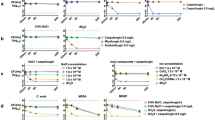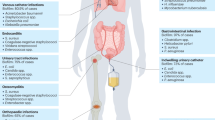Key Points
-
Miconazole oral gel is sufficiently absorbed to interact with warfarin, and possibly other drugs.
-
Fluconazole is absorbed and can interact with several drugs.
-
Drug interactions should always be considered by dental practitioners prior to drug prescribing.
Abstract
Miconazole oral gel is frequently prescribed for the treatment of oral Candidal infections. Its ability to be systemically absorbed and interact with other drugs has previously been recorded but is not universally known. As a reminder, a further case of derangement of anticoagulation following concomitant use of warfarin and miconazole is reported. Other potential drug interactions of miconazole and fluconazole are highlighted.
Similar content being viewed by others
Main
In 1998, in this journal, we reported three cases of derangement of anticoagulation following the concomitant use of warfarin and miconazole oral gel.1 We have subsequently undertaken a survey of general dental practitioners, the results of which indicate that up to a third of practitioners are still unaware of contra-indications or problems associated with the prescribing of azole antifungal agents. As a reminder of the potential for serious drug interaction, we report here a further case which illustrates the ability of miconazole oral gel to affect warfarin anticoagulation.
Case report
A 62-year-old man was referred to the Oral Medicine Unit of the University Dental Hospital of Manchester by his general dental practitioner. The patient's complaint was of intermittent soreness affecting his tongue, which had been occurring over a 5 month period. The patient had consulted his general medical practitioner some 3 months previously who had prescribed miconazole oral gel which the patient had used on a symptomatic basis since then.
The patient's medical history revealed that 4 years previously he had suffered a thrombosis affecting his large bowel and that he was currently suffering from irritable bowel syndrome and bladder cancer. His only regular medication was warfarin and until recently his INR had been checked every 6 weeks. He had previously been well stabilised on 5 to 5.5 mg warfarin daily, giving an INR between 3.5 and 4.5.
Two months prior to his visit to the Oral Medicine Unit (ie 1 month after commencing use of miconazole oral gel) he had reported haematuria at a routine visit to the anti-coagulant clinic. At this stage his INR was checked and found to be 11.9. He was admitted to hospital, his warfarin stopped and his INR subsequently fell.
The patient was discharged a week after admission with an INR of 3.1 and was put back on his maintenance dose of warfarin, 4.5 mg daily. He once more resumed his symptomatic use of miconazole oral gel and at subsequent visits to the anticoagulant clinic his INR rose to a maximum of 5.8 necessitating a progressive reduction in his warfarin dosage to 3.5 mg daily. The latter was the lowest stabilising dose of warfarin the patient had taken since his treatment commenced 4 years previously.
At his visit to the Oral Medicine Unit the patient was advised of the interaction between miconazole and warfarin and his haematologist contacted so that the patient's INR could be monitored following withdrawal of the miconazole. The patient had not previously informed his haematologist about the miconazole oral gel, as he had not thought it relevant. The patient's INR initially fell after the miconazole was finally withdrawn but then stabilised as his dosage of warfarin was increased. With respect to his oral symptoms, there was no clinical evidence of candidosis, and swabs and smears proved negative. The diagnosis subsequently proved to be one of traumatic ulceration.
Discussion
Imidazole antifungal agents such as miconazole, and triazole antifungal agents such as fluconazole, have the potential for drug interactions. This is because these agents inhibit the cytochrome P-450 enzyme system in the liver, thereby decreasing the clearance of several other drugs.2
Miconazole was originally developed during the 1970s as a systemic antifungal agent and was originally marketed in an intravenous and oral form. For most of its original systemic indications it has been superseded by other antifungals, and it is now mainly used in topical applications. Several drug interactions were noted early on in its systemic use,3,4,5,6 and the interaction with warfarin has been subjected to further investigation.2 A controlled study of miconazole 125 mg per day taken orally over 3 days, on the response and kinetics of a single dose of warfarin in healthy individuals, showed that miconazole significantly decreased the clearance of warfarin. The subsequent anticoagulation effect was enhanced 5-fold. Hence while it was known that miconazole could be absorbed from the gut, it was less obvious that miconazole from a topically applied product such as miconazole oral gel, could also be absorbed in sufficiently large amounts to have this potential. There have now been several reports in the literature of the interaction between warfarin and miconazole in its oral gel form, confirming its ability to be absorbed.1,3,7,8,9,10,11,12,13 Most of the reported cases have presented after 1 to 2 weeks of concomitant drug administration, although in one case it has been as short as 2 days.11 Furthermore, other sources of mucosal absorption have now also been implicated in causing this interaction. Derangement of warfarin anticoagulation has been reported following vaginal administration of miconazole for the treatment of Candidal vaginitis.14,15,16 Indeed, in the United States and Canada, explicit warning of the risk of this particular interaction has now been placed on all over-the-counter vaginal products containing miconazole following recommendations from the drug licensing authorities.15,16 More recently, derangement of warfarin anticoagulation following the use of over-the-counter miconazole cream for groin intertrigo has been reported; the first report involving absorption through the skin.17
It remains unclear how much miconazole is absorbed from its use as oral gel and how frequently drug interactions follow its use in this form. Apart from the interaction with warfarin, and the other coumarin anticoagulant, acenocoumarol,18,19,20 we have been unable to find any published case reports of other drug interactions arising from its use in this way. There are however, several potentially hazardous interactions if enough miconazole is absorbed. It would thus seem prudent that caution should be exercised in its prescription in patients taking certain groups of drugs. Important interactions for fluconazole and miconazole that have been identified as potentially hazardous are given in Table 1.21 The British National Formulary counsels that miconazole oral gel is absorbed to the extent that care is needed to take account of potential interactions.21
As well as being available on prescription, miconazole oral gel is also available as a pharmacy only medicine, which allows it to be sold over-the-counter in pharmacies under the supervision of a registered pharmacist. The product information leaflet which accompanies the 15 g tube available for sale in this way, warns patients to inform their doctor or pharmacist if they are taking any other medicine before commencing use of the miconazole oral gel. It also explicitly warns patients not to take miconazole oral gel if they are also taking certain antihistamines, lipid regulating drugs, midazolam, pimozide, quinidine and dofetilide. There is however, no specific mention of the interaction with the anticoagulants warfarin or acenocoumarol.
Miconazole when used in the oral gel form has the potential to be absorbed. There is clear evidence that it has interacted with coumarin anticoagulants as a consequence of this absorption. Where there is a risk of a hazardous drug interaction, polyene antifungal agents, such as Nystatin or Amphotericin, should be used where possible. If concurrent use of warfarin and miconazole oral gel is required, the INR should be closely monitored. We also suggest that the over-the-counter preparation of miconazole oral gel should contain a specific package-warning regarding the risks of a drug interaction to patients also taking coumarin anticoagulants.
References
Pemberton MN, Sloan P, Ariyaratnam S, Thakker NS, Thornhill MH . Derangement of warfarin anticoagulation by miconazole oral gel. Br Dent J 1998; 184: 68– 69.
O'Reilly RA, Goulart DA, Kunze KL et al. Mechanisms of the stereoselective interaction between miconazole and racemic warfarin in human subjects. Clin Pharmacol Ther 1992; 51: 656– 667.
Watson PG, Lochan BG, Reddind JV . Drug interaction with coumarin derivative anticoagulants. Br Med J 1982; 285: 1045– 1046.
Meurice JC, Lecomte P, Renard JP, Girard JJ . Interaction miconazole et sulfamides hypoglycemiants. Presse Medicale 1983; 12: 1670.
Rolan PE, Somogyi AA, Drew MJR, Cobain WG, South D, Bochner F . Phenytoin intoxication during treatment with parental miconazole. Br Med J 1983; 287: 1760.
Horton CM, Freeman CD, Nolan PE, Copeland JG . Cyclosporine interactions with miconazole and other azole-antimycotics: a case report and review of the literature. J Heart Lung Transplant 1992; 11: 1127– 1123.
Colquhoun MC, Daly M, Stewart P, Beeley L . Interaction between warfarin and miconazole oral gel. Lancet 1987; I: 695– 696.
Shenfield GM, Page M . Potentiation of warfarin action by miconozole oral gel. Aust NZ J Med 1991; 21: 928.
Pillans P, Woods DJ . Interaction between miconazole oral gel (Daktarin) and warfarin. NZ Med J 1996; 109: 346.
Evans J, Orme DS, Sedgwick ML, Youngs GR . Treating oral candidiasis: potentially fatal. Br Dent J 1997; 183: 87.
Marco M, Guy AJ . Retroperitoneal haematoma and small bowel intramural haematoma caused by warfarin and miconazole interaction. Int J Oral Maxillofac Surg 1997 ; 27: 485.
Silingardi M, Ghirarduzzi A, Tincani E, Iorio A, Iori I . Miconazole oral gel potentiates warfarin anticoagulant activity. Thromb Haemost 2000; 83: 794– 795.
Ogard CG, Vestergaard H . Interaction between warfarin and miconozole oral gel. Ugeskr Laeger 2000; 162: 5511.
Thirion DJG, Zanetti LAF . Potentiation of warfarin's hypoprothrombinemic effect with miconazole vaginal suppositories. Pharmacotherapy 2000; 20: 98– 99.
Murty M . Miconazole-warfarin interaction: increased INR. CMAJ 2001; 165: 81– 82.
US Food and Drug Administration (FDA). FDA talk paper: Miconazole Vaginal cream and Suppositories safety information. Rockville: FDA, 2001.
Devaraj A, O'Beirne JP, Veasey R, Dunk AA . Interaction between warfarin and topical miconazole cream. Br Med J 2002; 325: 77.
Marotel C, Cerisay D, Vasseur P, Rouvier B, Chabanne JP . Potentialisation des effets de l'acenocoumarol par le gel buccal de miconazole. Paris Medicale 1986; 15: 1684– 1685.
Ducroix JP, Smail A, Sevenet F, Andrejak M, Baillet J . Haematome oesophagien secondaire a une potentialisation des effets de l'acenocoumarol par le gel buccal de miconazole. Rev Med Interne 1989; 42: 412– 413.
Ortin M, Olalla JI, Muruzabal MJ, Peralta FG, Gutierrez MA . Miconazole oral gel enhances acenocoumarol anticoagulant activity: a report of three cases. Ann Pharmacother 1999; 33: 175– 177.
British National Formulary. 55.London: BMA, RPS, 2002.
Author information
Authors and Affiliations
Corresponding author
Additional information
Refereed Paper
Rights and permissions
About this article
Cite this article
Pemberton, M., Oliver, R. & Theaker, E. Miconazole oral gel and drug interactions. Br Dent J 196, 529–531 (2004). https://doi.org/10.1038/sj.bdj.4811224
Received:
Accepted:
Published:
Issue Date:
DOI: https://doi.org/10.1038/sj.bdj.4811224
This article is cited by
-
The Pharmacokinetics and Target Attainment of Antimicrobial Drugs Throughout Pregnancy: Part III Non-penicillin and Non-cephalosporin Drugs
Clinical Pharmacokinetics (2023)
-
Pharmacokinetics and Target Attainment of Antimicrobial Drugs Throughout Pregnancy: Part I—Penicillins
Clinical Pharmacokinetics (2023)
-
Inhibition of Cytochrome P450s by Strobilanthes crispus Sub-Fraction (F3): Implication for Herb–Drug Interaction
European Journal of Drug Metabolism and Pharmacokinetics (2022)
-
Morbidity and mortality associated with the interaction of miconazole oral gel and warfarin
British Dental Journal (2018)
-
Diagnosis and management of oral candidosis
British Dental Journal (2017)



